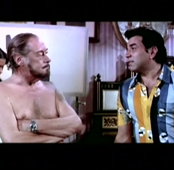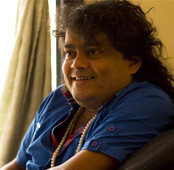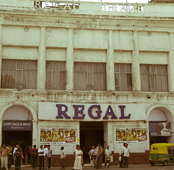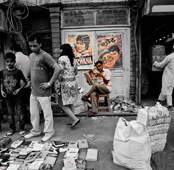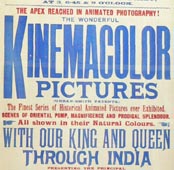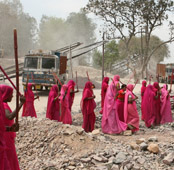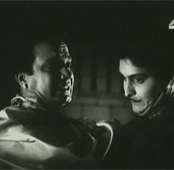THE POSTER BOY
In 2002 filmmaker Anurag Kashyap was playing a character named
Fanidhar in a play called Sir Sir Sarla. Fanidhar, a brilliant, passionate
young man, had trouble expressing himself. With unkempt hair and
bloodshot eyes, he mumbled and stuttered through the play– pitied or
mocked by other characters. The only time he let himself be heard,
loud and clear, was a scene where he found himself alone in a room. He
screamed out poetry in a recitation that stole the thunder. Kashyap was
30 then. He had made Paanch, a dark, gritty morally ambivalent movie
that was stuck at the censors.
In 2005 I had approached Kashyap at his Versova flat in Mumbai with
a facetious questionnaire for a lifestyle magazine. Paanch still hadn’t
released. And his second film Black Friday, an account of the 1992
Bombay bomb blasts, was held up because the case on which the film
was based was subjudice. When asked what he would like to change
about himself Kashyap said: “I want to make a releasable film”. What’s
your greatest fear? “That I become corruptible, insecure, lose originality
and make a film for any other reason than the desire to make it.”
Kashyap, who turned 40 this month, is now called ‘the poster boy of
Indian independent cinema’ by the media. Paanch is still unreleased but he has made seven other “releasable” films – Black Friday, No Smoking, DevD, Gulal, That Girl In Yellow Boots and Gangs Of Wasseypur (GOW) 1 and 2. And he’s made them pretty much on his own terms, on dark, unconventional subjects, mostly with no big stars. 2 years ago he set up his own production house Anurag Kashyap Films Private Limited (AFKPL) which has produced and released 3 of his own films—That Girl In Yellow Boots and GOW 1 and 2—and 2 films by new directors: Vikramaditya Motwane’s Udaan and Bejoy Nambiar’s Shaitan. They have 5 more productions in line which also promise to stand apart from the run-of-the-mill Bollywood movie: Michael, Monsoon Shootout, Tasher Desh, Shahid and Haraamkhor.
It’s not that filmmakers like Dibakar Banerjee or Tigmanshu Dhulia aren’t
suitable candidates to represent the hindie, but what makes brand Anurag
Kashyap the best bet for kicking up a storm over independent cinema, more than his recent successes, are the lower depths of his past. Every report on him resuscitates his
long years of struggle, and the irony of the fact that his first film hasn’t
seen the light of day. The stories have been repeated often enough to
fortify his brand: the firebrand messiah of new cinematic talent. A recent
Cadbury ad shows him yelling into his cell phone at his casting
director for not being able to find actors for his latest film. Kashyap is
not asking for stars. He is asking for actors with the precise typicalities
that his characters have. 4 girls on the next table cannot contain their
excitement when they overhear him. They meet his requirements exactly.
When Kashyap turns around and notices them he grins wide. He has
found his cast.
This brand is what the poster boy uses to lobby for the release of films
that are stuck, promote indies he likes in the press and on social media,
pick battles with Bollywood heavyweights, build a network that connects
financiers to aspiring filmmakers, and, if nothing else, allow a fledgling
filmmaker to write “Anurag Kashyap presents”.
This year, AKFPL’s 2 entries into the Festival de Cannes – GOW and
Vasan Bala’s Peddlers – have added substantially to this brand. This is
AKFPL’s second season at the coveted film fest, the first being when
Motwane’s Udaan was admitted in 2010. It is through such trysts with
the international that the production company has built a reputation for
discovering channels of distribution and funding for its films in countries
as far off as Japan, Norway and Brazil.
Guneet Monga, Kashyap’s partner at AFKPL, has been the force behind
opening up many of the above mentioned channels. Kashyap has often called her “our hero”. Her twitter tagline reads, “Let’s all come together to support the Indian indie”. She met me on July 24 in her sparse office that lies inconspicuously on a dirt track in a quaint Versova neighborhood called Aram Nagar.
High on the success of GOW, she seemed indefatigable. GOW 1 and 2 had
been made for Rs 40 crores, she claimed, including publicity and release
expenses. GOW 1 had already netted Rs 30 crores. It had just opened in
Singapore and France. It had been running for over 4 successful weeks
in the UAE. GOW 2 was yet to release. But with the satellite sales of GOW
1 Monga said “the film is already in profit”.
Bala’s Peddlers, on the other hand, has been made for just Rs 2 crores.
Rs 1 crore was crowdsourced from Facebook, from ten investors who
paid Rs 10 lakh each – the minimum an investor had to contribute. Another Rs 1 crore comprised promised payments to cast and crew, which were deferred until after the money was made up. The Indian exploitation rights for the film have been sold to Eros International Media Ltd., which has bought into it for a 50% partnership with AKFPL. The film is slotted for a January release here, whenever Monga finds a “freer Friday” on at least 200 screens throughout the country. And the international exploitation rights are being handled by The Wild Bunch, who have also been agents for The Artist, in return for a commission. On the day of our meeting, they already sold rights worth $ 150000 (over Rs 81 lakh) for France, Germany, Geneva, Brazil and the Scandinavian countries. Monga is also planning to earn money from Video On Demand (VOD) for Peddlers, and from sales to American universities after it “gets admitted into a major North American festival which I don’t want to name now”, but which, presumably, was the Toronto International Film Festival this month where Peddlers was shown in the City to City section. Monsoon Shootout is following the same path with a lot of international names involved at various stages of its production and distribution. Similarly, AKPL’s Lunchbox has been partly financed by the Medienboard Berlin-Brandenburg, a government body, in Germany.”They said we had to spend 150% of the money given by them in Germany,” says Monga. “We couldn’t shoot the film there, so Berlin is where we’re doing the post-production.”
Almost as if to sign off on its international cachet, AKFPL is co-producer
for Michael Winterbottom’s Trishna and No Man’s Land Director Danis
Tanovic’s next.
Monga says the way in which they choose their movies is “a personal
process”. “Anurag reads the script, and I meet the director,” she
says. “We have to fall in love with both the script and the director.”
This process naturally precludes a lot of talent that does not personally appeal to the AFKPL head honchos. Indie filmmaker Hemant Gaba, who made Shuttlecock Boys said in an interview with IBN Live: “I did get in touch with his (Kashyap’s) production house.” “My film did not match the criteria of the kind of films he endorses. They prefer more like a gritty, hard-hitting, dark film.” He doesn’t hold this against Kashyap however: “Anurag is the face of independent cinema but he cannot be the father of all films.”
Detractors seem skeptical about whether the films produced by AKFPL,
besides those directed by Kashyap, will see a theatrical release. Monga
believes in waiting. She believes January, February and March are the
best months to launch an Indian indie. She doesn’t want to compete with
the blockbuster releases around the Diwali-Dussehra season, or even the
Christmas releases. Hence the delay.
There is more criticism. Some indie filmmakers have, on record, yet
on condition of anonymity, expressed reservations about GOW being
called an independent film. And this is not just because it has been co-
produced by Viacom 18 Motion Pictures (also called Studio 18), owned by Viacom Inc., which, ironically, also owns Paramount – one of the 6 major studios in the US. While Monga believes indie filmmaking is about “entering a newer space” away
from “formula cracked content” one of these filmmakers believes GOW
“uses the formula as much as an ’80s blockbuster does”. “Independence
is about breaking new ground,” says another. “But stylistically GOW is a
return to Satya (a 1998 film by Ram Gopal Varma that Kashyap wrote).”
The fact that none of these voices agreed to having a name put to them
for seemingly innocuous, constructive criticism of the categorization of
Kashyap’s magnum opus could be an indicator of Kashyap’s perceived
clout as the messiah of the indie. Or perhaps the insecurity that is known
to plague the Mumbai film industry at large has also trickled down into
its ‘independent’ circuits.
Meanwhile, Kashyap has commented on this blurring of boundaries
between ‘parallel’ and ‘commercial’ in GOW. “You’re right in that
GOW is straddling two worlds,” said Kashyap in an interview to
Starblockbuster.com. “We have an unconventional cast, but the film is as
commercial as Bollywood… ”
Still, it is this “unconventional cast” which allows GOW to retain a
defiance of the mainstream: it is sans the aura of Bollywood stardom that
would typically envelop such an epic.
Kashyap’s next directorial venture Bombay Velvet will feature Bollywood
star Ranbir Kapoor. “But AKFPL isn’t producing Bombay Velvet – Phantom
(Films) is,” says Monga, defensively. “And that (the fact that it has a mainstream star) is exactly why.” Phantom Films is Kashyap’s newest baby, a production house that he launched last year with protégé Motwane and producers Vikas Bahl (former head of UTV Spotboy) and Madhu Mantena (who produced Ghajini). The same production company, financed partly by Studio 18, is also producing Lootera, directed by Motwane, starring Ranveer Singh and Sonakshi Sinha. To some filmmakers, Phantom is the sign of Kashyap slouching towards Bollywood.
This wouldn’t have really been a problem if Kashyap hadn’t, wittingly
or unwittingly, become the poster boy of hindie. Independent cinema
with a poster boy is a bit like communism with a dictator: too much
hinges on too little. Kashyap is simply being asked to stand up for what
he’s been seen as standing for. His working with stars is being seen as
one would see Anna Hazare joining politics – it’s not wrong, as much as
inappropriate. Also because stars, while often guaranteeing numbers
at the box office, overwhelm cinema with exactly the kind of baggage
an indie filmmaker wants to avoid. Shonali Bose, who made Amu, was
approached by a big production house she doesn’t want to name for
the script of her next movie Margarita, With a Straw. “They wanted to try and cast
someone like Kareena Kapoor or Priyanka Chopra in the lead character of
a paraplegic,” says Bose. “I refused.”
Yet this debate begs questions of a more complex nature. After having
proved himself as a filmmaker who does not need stars to fund his films,
must Kashyap continue to refrain from casting a star? Even if the star
in question has proven his mettle as an actor? It may be difficult to
categorize Bombay Velvet as an independent film but it does have a little
bit of the spirit that pervades indies—the spirit of thinking out of the box—because there is something to be said for the fact that its script has been written by Gyan Prakash, the Dayton Stockton professor of History at Princeton University, one of the most prominent Indian historians today. At a time when the Hindi film industry has been crying out for good writers, and not being able to look for them beyond its immediate ambit, Kashyap has taken inspiration for his film from a critically acclaimed non-fiction book written by a hard-boiled academic.
Ten years after he played Fanidhar, Kashyap might be closer
to Bollywood that one could have imagined but not enough for his
worst fears to come true. I’m at a Versova cafe called Chai-Coffi. 3 struggling actors at the next table begin a discussion about whether the films being made nowadays are really different, and better. One of them claims he was a part of the theatre troupe that staged Sir Sir Sarla. “Do you know the story of Paanch?” he asks his companions, and begins its telling. Like every other newspaper report on Kashyap he tries to recreate that image of a man shouting out poetry from within a room. Only now the doors and windows have been flung open, and people have gathered to listen. Here’s hoping he does not run out of breath.
Keeping Up With The Indie Joneses
ArticleSeptember 2012
 By Rishi Majumder
By Rishi Majumder
Rishi Majumder is Senior Editor at The Big Indian Picture.


